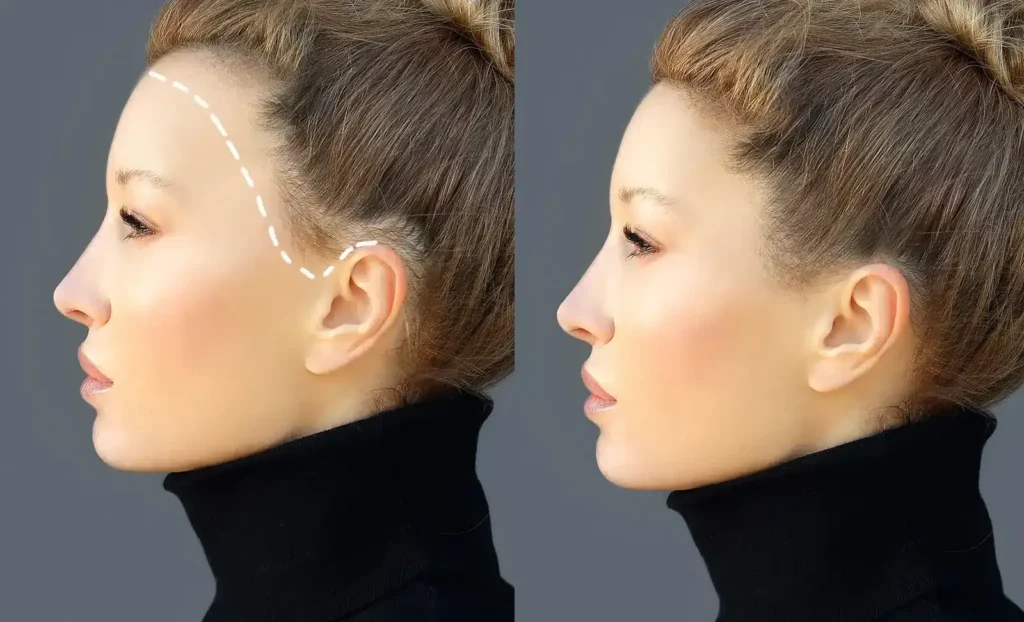Worried about having a visible scar after your hairline lowering surgery? You’re not alone. A hairline lowering surgery scar is a common concern among individuals seeking a lower forehead or more balanced facial proportions.
In this post, you’ll learn what the scar looks like, how it heals over time, and expert-backed tips to minimize its appearance. With proper aftercare and realistic expectations, you can confidently move forward in your hairline transformation journey.
Understanding Hairline Lowering Surgery
What Is Hairline Lowering Surgery?
Hairline-lowering surgery, also known as forehead reduction or hairline advancement, is a cosmetic procedure that reduces the height of the forehead by surgically moving the hairline forward. It typically involves removing a strip of forehead skin and securing the scalp closer to the brow line.

Why People Choose It (Cosmetic and Medical Reasons)
- To correct a naturally high hairline
- To improve facial symmetry or proportions
- To restore a youthful appearance
- To correct hairline changes due to genetics or prior surgery
Ideal Candidates for the Procedure
- Individuals with flexible scalp skin
- Those with a stable hairline and no significant hair loss
- Patients in good general health and with realistic expectations
- Often recommended for women, though men may also qualify with careful planning
Where and Why Scars Occur After Hairline-Lowering Surgery
Incision Techniques and Placement
Surgeons typically place the incision along the natural hairline, using a trichophytic technique that allows hair to grow through the scar, making it less visible over time.
Skin Type, Genetics, and Scarring
Scarring varies by:
- Skin tone and type: Darker or very fair skin may be more prone to pigmentation changes.
- Genetic predisposition: Some people naturally develop thicker or keloid scars.
- Healing response: Infections or tension on the wound can worsen scar outcomes.
Surgeon Skill and Scar Minimization
A highly skilled, board-certified surgeon can reduce scar visibility through:
- Precision incision placement
- Tension-free closures
- Post-op wound care planning
What Does a Hairline-Lowering Surgery Scar Look Like?
Healing Timeline and Scar Appearance Over Time
- Week 1–2: Red, slightly raised line along the hairline
- Months 1–3: Scar flattens, redness fades gradually
- Months 4–6: Scar blends with skin and hair growth
- 1 Year: In most cases, the scar becomes barely noticeable
Common vs. Complicated Healing Patterns
Normal: Flat, pink to skin-colored, gradually fading scar
Complicated: Thick, itchy, keloid, or hypertrophic scars requiring treatment
Hairline-Lowering Surgery Scar Healing Timeline
Week-by-Week Recovery Overview
- Days 1–7: Swelling and mild discomfort; sutures may be visible
- Week 2–3: Sutures removed; redness at incision site
- Weeks 4–8: Scar begins maturing; mild numbness may persist
- Months 3–6: Hair regrowth over the scar starts; discoloration fades
- 6–12 months: Final scar appearance is evident
When to Expect Redness, Swelling, and Scar Maturation
Redness typically fades within 3 months. Scar maturation continues for up to a year, depending on age, skin type, and adherence to aftercare.
Signs of Normal vs. Abnormal Healing
✅ Normal: Smooth scar, no drainage, gradual color fading
❌ Abnormal: Thickening, itching, pain, pus—requires medical evaluation
How to Minimize or Treat Hairline-Lowering Scars
Post-Operative Care Tips from Surgeons
- Keep the area clean and dry
- Avoid sun exposure (use SPF 30+)
- Do not scratch or pick at the healing site
- Sleep with your head elevated for the first week
- Follow all aftercare instructions closely
Recommended Scar Creams, Oils, and Silicone Sheets
- Silicone gel sheets (e.g., ScarAway, Mederma): promote flat, soft healing
- Vitamin E or onion extract-based creams may aid early healing
- Cica-based ointments: reduce redness and support the Skin barrier
Laser Therapy and Microneedling for Scars
Professional treatments can enhance scar outcomes:
- Fractional CO2 laser: Improves texture and pigmentation
- Microneedling + PRP: Stimulates collagen, flattens scar

Always consult your surgeon before starting these treatments.
When Is Scar Revision Surgery Necessary?
- Thick, raised, or stretched scars
- Poorly placed or highly visible scars
- Usually done 6–12 months post-op if conservative methods fail
Lessons Learned from Personal Recovery Journeys
- Stick to your surgeon’s instructions
- Use scar creams early (after sutures are removed)
- Be patient—results take time
- Don’t panic if the scar looks red early on—it fades!
Expert Advice for a Smooth Recovery
Tips from Board-Certified Hair Restoration Surgeons
- Choose a surgeon with proven results in hairline surgery
- Discuss incision technique options during consultation
- Ask to see before/after photos of previous patients
Lifestyle Adjustments That Help
- Avoid smoking and alcohol (impede healing)
- Eat a nutrient-rich diet (protein, vitamin C, zinc)
- Stay hydrated
- Wear a hat when outside (after wound closure) to protect from UV exposure
Frequently Asked Questions (FAQs)
How long does the scar from hairline-lowering surgery take to heal?
Most scars fade significantly within 6–12 months, depending on skin type and care.
Will the scar be visible forever?
With proper surgical technique and aftercare, the scar often becomes barely visible, especially with hair regrowth.
Can I get a hair transplant to cover the scar?
Yes, FUE hair transplant can help camouflage a scar if needed.
Is hair growth over the scar possible?
If a trichophytic closure is used, hair may grow through the scar for a more natural look.
What happens if the scar stretches or thickens?
Scar revision or laser therapy may be considered. Consult your surgeon if it becomes raised or painful.
Take your next step, Hair Restoration Specialist in Islamabad
Concerned about scarring after your hairline-lowering procedure? Get expert advice and personalized care from Dr. Rana Irfan, an ABHRS and ISHRS-certified hair restoration surgeon with extensive experience in hairline design.
Book your consultation today to ensure the safest and most natural-looking results.
